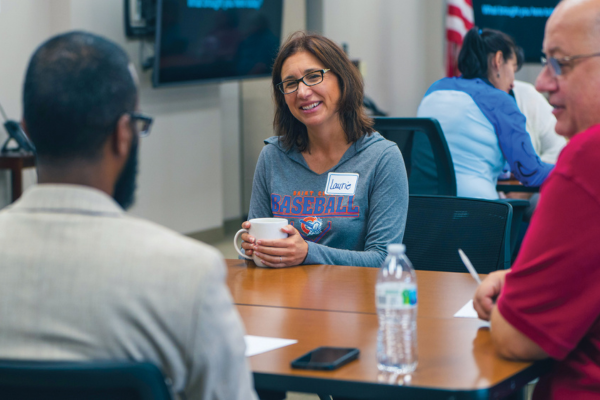Re-examining Beliefs About Students in Poverty
May 01, 2016

This is a fact: Students whose families are living in poverty do not perform on average as well in school as wealthier students. Perhaps it’s unpopular to say, but if we’re committed to educational equity for low-income families, we must acknowledge this reality.
The next step is to consider how we interpret it. We might ask ourselves how we would answer this question: Why do students whose families are experiencing poverty not do as well in school on average as their wealthier peers? Obviously, the answer is complex, many factors are in play. But if we get to the root of it, what factors do you believe best explain the disparities in educational outcomes for low-income students?
Equity Literacy
I have spent the past dozen years cultivating in teachers and administrators the skills and knowledge for building equitable learning environments for students in poverty — the knowledge and skills necessary to make every educator a threat to the existence of inequities in their classrooms, schools and districts. Along with my colleague Katy Swalwell, I have come to call this combination of knowledge and skills equity literacy. It begins with analyzing our belief systems, our responses to the question I posed above. More on that below.
Briefly, equity literacy consists of four abilities essential to creating equitable schools. When we equip ourselves with these abilities, we become a threat to the existence of inequities in our spheres of influence — our classrooms, schools or districts.
The first is the ability to recognize inequity. Do I understand the challenges students experiencing poverty face outside school well enough that I recognize even the subtlest ways in which those challenges are reproduced within schools? Am I capable of recognizing stereotypical depictions of people experiencing poverty when I flip through a textbook under consideration for adoption in my school or district?
The second is the ability to respond to inequity in the immediate term. Am I able, for example, to skillfully explain to colleagues why adopting a policy requiring electronic communication with parents could exacerbate gaps in family engagement? Do I know how to respond to colleagues openly and effectively when they stereotype families experiencing poverty? Do I have the ability and the will to challenge increases in extracurricular fees, the under-representation of low-income students in upper-level courses and other practices that disproportionately marginalize the most economically disadvantaged students?
Next is the ability to redress inequity in the long term by tending to the conditions that underlie immediate concerns. For example, am I willing to develop policy, however unpopular it might be among wealthier families, to disallow practices that humiliate and disadvantage students experiencing poverty? Can I skillfully exert my influence to lead a reconsideration of fundraising activities that rely on sales competitions among students, book fairs full of resources low-income families could never afford, homework assignments requiring the use of technology to which many economically disadvantaged students do not have access, or first-day-of-school share-outs about what students did on their summer “vacations.”
(Of course, if I don’t recognize how these practices and activities can be humiliating, it would never occur to me to redress them.)
The final ability involves sustaining equity. Do I know how to sustain equity efforts and do I have the will to withstand the criticism that occurs when I start to redistribute educational opportunity?
Genuine Intentions
The reason I love doing equity literacy work with schools, collaborating with people who have invested their lives in the success of other people’s children, is that I know I can assume good intentions among my collaborators. I can’t remember ever visiting a school where administrators didn’t genuinely want all students to thrive. Only rarely have I visited a school district where leadership wasn’t pouring resources into initiatives they believed would improve learning outcomes of low-income students.
Unfortunately, absent a commitment to equity literacy, good intentions and a willingness to expend resources pose no real threat to inequities. And this, in my experience, is the biggest barrier when it comes to matters of poverty and education: Too many popularly embraced strategies are not based on deep understandings of equity. They are based, instead, on well-meaning misunderstandings and understandably desperate grasps for the kinds of quick fixes that simply do not exist.
This brings me back to my original question: Why do students in poverty not perform as well in school on average as their wealthier peers? The first step toward equity literacy is assessing our existing perceptions. Any time I work with education leaders, helping them evaluate their abilities to lead equity efforts, I begin with this question. Responses cluster around three basic views of poverty, or three poverty ideologies. We start here because the ideology we embrace determines the way we interpret the problem we’re trying to resolve. The way we interpret the problem drives the solutions we’re capable of imagining to resolve it. I’ll show you what I mean.
A Deficit Ideology
The most common and most dangerous poverty ideology is deficit ideology, often perpetuated by training programs that focus on the mythical “culture” or “mindset” of poverty. If I embrace a deficit ideology, my impulse upon reading our question is to point to supposed deficiencies in the values or cultures of families in poverty. The students are unmotivated, I might think, or the parents are irresponsible. Perhaps, I reason, poor people don’t value education.
Here’s a dose of equity literacy. As it turns out, all of these presumptions are false — they are stereotyped misinterpretations that render us a threat to equity, not to inequity. For example, researchers have found no discernible differences between how people in poverty and wealthier people value education.
When I misinterpret in this way, despite good intentions, I risk investing resources in initiatives designed to solve problems that don’t exist. Consider initiatives designed to persuade low-income parents to care more about education. They already care. So now I’ve wasted resources and alienated the most marginalized families. That’s the inverse of equity.
Grit Ideology
The second poverty view is grit ideology. If I embrace grit ideology, I might respond to our question lamenting a perceived lack of resilience in low-income students. Perhaps I would acknowledge the barriers they face, such as the lack of access to preventive health care. But rather than developing strategies that are responsive to these barriers, I sidestep equity and opt for initiatives designed to cultivate their grit so they can overcome them.
With equity literacy I understand that, contrary to popular belief, the most marginalized individuals generally already are the grittiest individuals. They are parents who, due to the scarcity of living wage work, juggle two or three jobs and still get their children to school. They are youth who persist despite school practices that sometimes humiliate them.
I understand, as well, that ignoring inequity, instead cultivating grit in students experiencing inequity, leaves us at inequity.
Structural Ideology
When I embrace structural ideology, I recognize that there simply is no way to eliminate educational outcome disparities without removing the barriers — the inequities — with which people experiencing poverty contend.
Research consistently shows that these barriers explain the largest portion of outcome disparities. Imagine, for example, how we would shrink disparities if every parent had one living wage job and could spend evenings helping their kids with homework and attending school events instead of working a second job. Imagine the change if every child had the best possible preventive health care. These two changes likely would have the biggest impact on low-income students’ performance.
I realize, of course, that these barriers fall outside my sphere of influence. I’m not in a position to promise every family living wage work, preventive healthcare, or a functioning automobile. But I am in a position to shape policy and practice to be responsive to these structural barriers.
Consider family involvement. We know that generally, low-income parents attend family involvement events at their children’s schools less often than wealthier parents. With troubling consistency, I come across well-meaning teachers and administrators who misinterpret this reality through a deficit lens. If only those parents cared more. When we misinterpret in this way, we render ourselves equity-illiterate. Equity cannot arise from bias.
A structural view allows me to consider the problem with deeper understanding. I start by wondering about my own complicity. Do I design opportunities for family engagement that are accessible to parents who work multiple jobs often including evening jobs, who don’t have paid leave, who may not have transportation, who might struggle to afford child care? Do the policies and practices I support mitigate or exacerbate these inequities? Do they redistribute access or punish people for their lack of access?
Positioning Ourselves
In the end, there is no path to equity not grounded in this structural view. When we strengthen our equity literacy, when we understand that educational outcome disparities can be traced almost entirely to structural barriers in and out of schools rather than to moral deficiencies or grit shortages in families experiencing poverty, we position ourselves to create equitable policy and practice.
Further, we position ourselves, as all education leaders should be positioned, to become a threat to the existence of inequity in our schools and districts.
Advertisement
Advertisement
Advertisement
Advertisement



